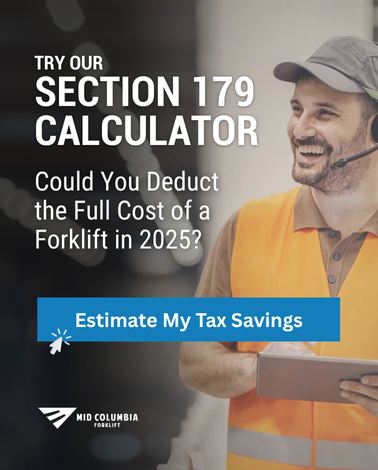Section 179 Could Save You Big on Forklifts, Floor Scrubbers, and More in 2025
by Cory Martin, on July 23, 2025 at 7:15 AM

Investing in new equipment is a big decision, and it’s human nature to wait. But thanks to a new tax law signed on July 4, 2025, there’s a compelling reason to purchase and put your next forklift, floor scrubber, or other equipment into use before the end of this year.
The updated Section 179 deduction may allow you to write off the entire cost of qualifying equipment in 2025, including new and used assets. That could mean major tax savings. Here’s what you should know.
What Is Section 179?
Section 179 is a part of the U.S. tax code that may let businesses deduct the full purchase price of qualifying equipment on their tax return for the year the equipment is placed in service.
Normally, businesses must depreciate equipment over several years. Section 179 accelerates this process, potentially allowing a full deduction in the same tax year the equipment is placed into service.
How It Works in 2025
Thanks to the new law signed on July 4, 2025, the Section 179 deduction limit was doubled, and 100% bonus depreciation is back. Here’s what that could mean for your business:
- Deduct up to $2.5 million under Section 179
- Bonus depreciation allows for 100% write-off on amounts above the Section 179 cap
- The deduction phases out after $4 million in equipment purchases
- Applies to new and used qualifying equipment
- Equipment must be delivered, installed, and ready for use by December 31, 2025, to qualify for a 2025 deduction.
For Instance…
Here's a hypothetical example to better explain the difference between a straight-line deduction and a Section 179 deduction.
Let's say your company buys $2,540,000 of material handling equipment in 2025. You predict that the equipment will remain in service for five years. On your taxes, you can use either straight-line depreciation or Section 179.
If you use typical straight-line depreciation, you'll divide that $2,540,000 by five and deduct that amount from your company taxes each year for five years. So, in this example, you'll deduct $508,000 each year starting in 2025 and ending in 2030.
Section 179 Tax Deduction Example
However, if you use Section 179 for the same purchase, your deduction would look like this:
- Total equipment purchase: $2,540,000
- Section 179 base deduction: $2,500,000 (the maximum for 2025)
- Bonus deduction: $40,000 (100% of the purchase price over $2,500,000)
- Total deduction for 2025: $2,540,000
Bear in mind, this is a hypothetical example used to illustrate the difference between these two deduction types. You can use our Section 179 Calculator to estimate your company’s Section 179 tax deduction. Be sure to consult your tax adviser to better understand how Section 179 will affect your organization.
What Qualifies for a Section 179 Tax Deduction?
All physical equipment qualifies for a Section 179 depreciation deduction so long as the expected life of the item is longer than one year. This means that all material handling and industrial cleaning equipment purchases are likely to meet the basic requirements. The following are just a few examples of what qualifies:
- Aerial equipment
- Forklifts
- Forklift attachments
- Loading dock doors and equipment
- Industrial cleaning equipment
- Utility vehicles
- Racking
- Warehouse automation hardware
- Pallet jacks and walkies
- Safety equipment
- Racking, shelving and Mezzanines
- Scales and inspection stations
- Warehouse lighting and security systems
- Batteries and charging stations*
To qualify for a 2025 deduction, your equipment must be delivered, installed (if required), and ready for use before December 31, 2025. Check out IRS Publication 946 for the specific rule.
* Battery and charging stations may qualify under Section 179 if they are tangible business equipment with a useful life of more than one year and are placed in service before December 31, 2025. For charging systems that require installation (such as wall-mounted or integrated power solutions), the full system—including labor and installation costs—may be eligible, but eligibility depends on how the IRS defines and classifies the improvement. Always consult your tax professional to confirm deductibility.
What About Financed or Leased Equipment?
Financing and leasing options may still qualify for the Section 179 deduction, even if full payment is spread out over time. This gives your business flexibility to manage cash flow while still potentially benefiting from a full deduction in 2025.
Just like with purchased equipment, financed or leased assets must still be placed in service by December 31, 2025 to qualify for a 2025 deduction.
Additional Tax Incentives for U.S. Manufacturing Investments
The 2025 law also introduced a new provision—Section 168(n)—that supports companies investing in Qualified Production Properties (QPPs).
You may be able to deduct the full cost of building and equipping eligible domestic production facilities in the year construction is completed. To qualify:
- Construction must begin after January 19, 2025, and
- Be completed and placed in service before January 1, 2031
QPPs include facilities used in manufacturing, production, or refining of tangible personal property. Qualifying improvements may include:
- Conveyor systems
- Dock and door equipment
- Automation and ventilation
- EV infrastructure
- Lighting and safety enhancements
Again, eligibility depends on several factors. Talk to your accountant or tax adviser early in the process.
What Are Qualified Production Properties?
The bill defines Qualified Production Properties (QPP) as "nonresidential real property used as an integral part of a qualified production activity, such as manufacturing, production or refining of tangible personal property."
Common eligible products include:
- New construction and improvements
- Reconfigurations
- Automation
- Installation of dock and door systems
- Conveyor belts, racking, and shelving
- Ventilation systems
- Electric vehicle infrastructure
However, there are some restrictions. Only domestic facilities qualify. Additionally, construction must start after January 19, 2025, but before January 1, 2029, and enter service prior to January 1, 2031. Be sure to consult your tax professional to ensure your purchases qualify.
The Time To Save Is Now
A Section 179 depreciation deduction can be a significant boon on your taxes.
Don't miss out on maximizing your deductions by investing in the equipment your company needs to grow. Our team is ready to help you make rapid, informed decisions on what equipment best fits your facility. Though we can't offer tax advice, we can work with your accountant to help you maximize your deduction.
Additionally, our flexible payment options include outstanding lease terms. That way, investing in your business also fits your budget. To learn more about investing in new equipment, contact us online or visit your local Mid Columbia Forklift.
Auburn 253-854-5438
Pasco 509-547-7413
Wenatchee 509-663-9009
Yakima 509-457-5137
Disclaimer: This information is provided for general educational purposes only and should not be construed as tax, legal, or accounting advice. Please consult a qualified tax professional before making decisions.
Further Reading
Forklift Purchasing Options: Buy, Lease, or Rent
Choose the Best Industrial Floor Scrubber for Your Operation
The Complete Guide To Getting and Maintaining a Li-ion Forklift Fleet





